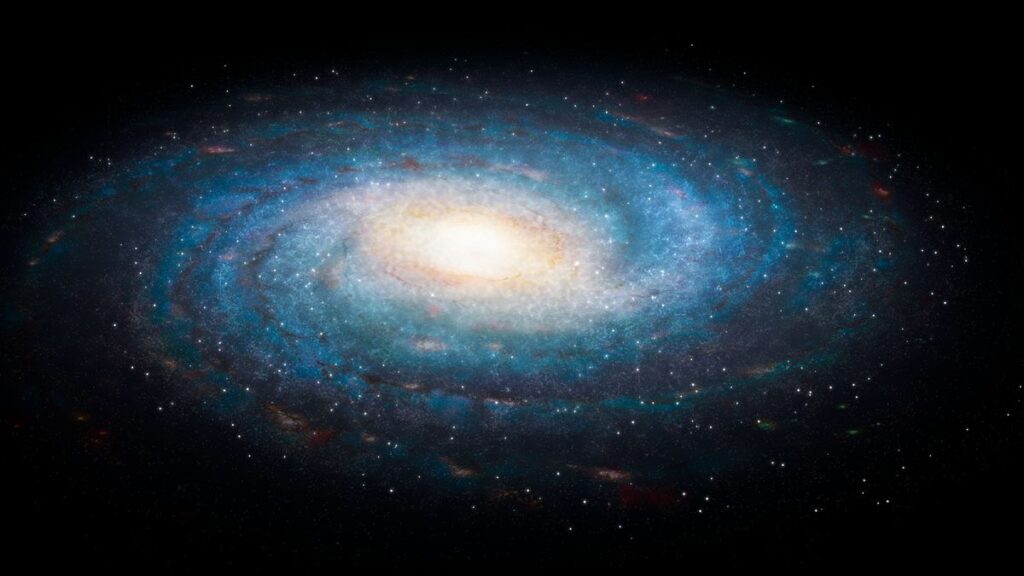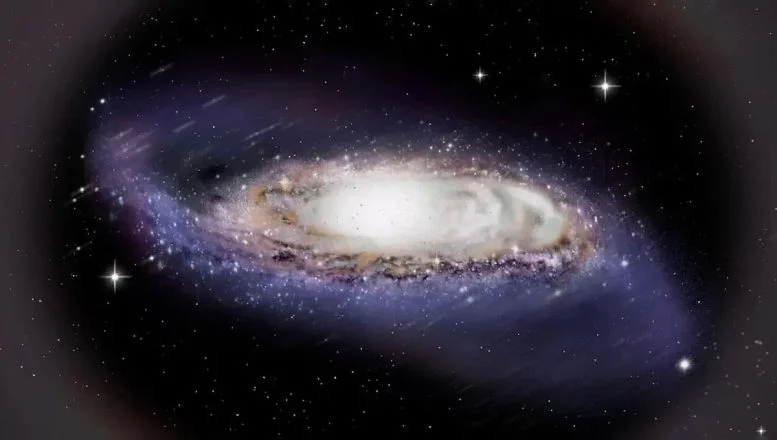
A research team created a new kind of “motion picture” for the measurement of the precession rate of the warp of the Milky Way. Their results show how slightly flattened the dark matter halo of the Milky Way is, shaping our understanding of galactic dynamics and the structure of the universe.
Astrophysicists pioneered a “motion picture” approach to measure the precession rate of the warp of the Milky Way’s disk. This sample of Cepheid variables clearly outlines the precession direction and rate of the warp of the Milky Way. With these observations in hand, the team demonstrated that the Milky Way’s dark matter halo turns out to be very slightly flattened at present times. A research team led by Dr. Yang Huang of the National Astronomical Observatories of the Chinese Academy of Sciences published the study in Nature Astronomy.
Astronomers have described this effect as a disk warp. Nearly one-third of the disk galaxies in the nearby universe are actually warped into a potato chip-like shape, rather than perfect disks. The Milky Way is a normal disk galaxy containing this type of feature. It is usually assumed that the warp is an outburst from the rotational plane of the outer disk stars from the symmetry plane of the surrounding dark matter halo. Hence, due to this, this tilted, rotating Galactic disk, similar to a spinning top, necessarily undergoes precession because of the torque applied by the surrounding dark matter halo.
Challenges in Measurement of Galactic Precession
However, the measurement of this very important dynamic parameter as far as direction and rate are concerned has widely been debated. This is attributed to the fact that previous measurements relied on indirect kinematic methods where the tracers used have been subject to dynamical perturbations or heating effects that greatly limited the accuracy and precision attained.
The present work used some 2,600 young classical Cepheid variable stars found by Gaia as tracers, whose distances and ages are very well determined by both Gaia and LAMOST. By this, they reconstructed a three-dimensional structure of the Milky Way’s disk, composed of populations with different ages—all less than 250 Myr—by using the “motion picture” method.
Galactic Disk Warp in a Spinning Top
Left panel: The spinning top precesses under the torque from gravity; Right panel: as with the spinning top, galactic disk warp “dances elegantly” under the torque of dark matter halo. Credit: Kaiyuan Hou and Zhanxun Dong from Shanghai Jiao Tong University
Results of Warp Precession and Galactic Dynamics
By “seeing” how the warping of the disk changed over time, the researchers managed to find out the precession of it in a retrograde direction at the rate of 2 km/s/kpc or 0.12 degrees per million years.
Measurements also have further evidence that the rotation rate of the warp was gradually decreasing with radius. Whichever its origin might be, the inner Galactic disk and dark matter halo had fixed the precession rate and the direction of the warp.
Implications for the Dark Matter Halo of the Milky Way
By subtracting the galactic inner disk, only the present dark matter halo enveloping the warp is of interest. It gets an ellipsoid with a slightly oblate shape; its equipotential surfaces have a flattening ratio q ~ 0.84-0.96. Only such a shape can reproduce the remaining precession rate of the warp up to date.
This would be one of the most important anchor points in the history of the evolutionary study of the Milky Way dark matter halo.
This is a breakthrough research piece: Dr. Yang Huang and colleagues not only discovered a sophisticated precession dynamics for the Milky Way warp but also provided great insight into what structure the Milky Way dark matter halo resembles. In contrast to the earlier methods that were indirect and prone to perturbations, this team used a quite revolutionary “motion picture” approach with Cepheid variable stars as tracers. These stars, very well measured over a range of ages and distances, allowed researchers to construct the three-dimensional map of the Milky Way’s disk warp clearer and more accurately than ever before.
It merely underlines one of the simplest, very basic points in galactic dynamics: there is interplay between the inner disk of the Milky Way and its surrounding dark matter halo. In this sense, the retrograde precession observed for the warp is found at 2 km/s/kpc and does not simply confirm theoretical predictions but puts the role of dark matter at the forefront for structuring galaxies over cosmic time. This will significantly improve our understanding of how dark matter shapes not only single galaxies but the broader cosmic landscape itself.
Now, the discovery reveals the slight oblateness of the dark matter halo of the Milky Way, characterized by a flattening ratio in the range of 0.84–0.96. With this discovery, new opportunities open up for investigating the nature of dark matter. This means that the halo turns out to be elliptical in shape, obtained from the residual precession rate of the warp after subtracting the contribution coming from the inner disk, challenging models and encouraging further studies on the origin and development of dark matter in galaxies. Such investigations will bring to the fore even deeper secrets about the ultimate nature and dynamics of our universe as astronomers further their methods and extend their datasets.

